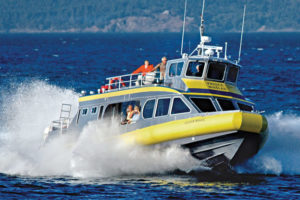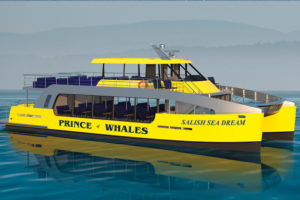Building the Boats that make
Northwest Whale Watching Happen
Words: Peter Marsh
 For anyone who cruises on the Salish Sea, sighting otters, orcas, and whales is a memorable event that gives us a magical glimpse of these marine mammals that spend most of their lives in difficult to reach places. But for the 36 dedicated whale-watching and ecotourism businesses in the Pacific Whale Watch Association, responsible wildlife viewing is a full-time business. These companies operate from 20 different ports in Washington and British Columbia, taking about 400,000 passengers out every year to inspire interest for conservation.
For anyone who cruises on the Salish Sea, sighting otters, orcas, and whales is a memorable event that gives us a magical glimpse of these marine mammals that spend most of their lives in difficult to reach places. But for the 36 dedicated whale-watching and ecotourism businesses in the Pacific Whale Watch Association, responsible wildlife viewing is a full-time business. These companies operate from 20 different ports in Washington and British Columbia, taking about 400,000 passengers out every year to inspire interest for conservation.
Each business needs staff to sell the tickets, identify the wildlife, and run and maintain a small fleet of boats. This constitutes a sizable locally-based nautical industry that came as a surprise to me. It does explain how whale-watching boats have become a recognizable design type and have evolved from small inflatables to 100-foot charter vessels. One of the leaders in the development of these vessels is the artfully-named Prince of Whales, with 13 vessels and bases in Victoria and Vancouver B.C. and close to 100 staff in peak season. The company’s newest addition to the fleet, the Salish Sea Dream, is a cutting edge piece of multihull design that you may see plying Pacific Northwest waters this summer. Fast, capable vessels are vital for viewing a pod of breeching whales, and the evolution of these boats is almost as interesting as the megafauna themselves.
from RIBs to Catamarans
The power catamarans of the eco-tourism business began in 1994 with Rigid-hull Inflatable Boats (RIBS). Now seen in every marina, the RIB was originally developed in the 1960’s by the British non-profit lifeboat society to work in the surf. The concept was picked up by scuba divers and they are now found in every marina as tenders and runabouts. Because of their low weight, RIBs are extremely fast and maneuverable. In our latitudes, every customer in a whale-watching RIB is likely to be wearing a floatation suit that serves as a life preserver and a survival suit.
Prince of Whales made some waves in the industry when they announced the intention to build a 62-foot aluminum version of the RIB. Local Naval architect John Simpson worked with NAIAD Inflatables of New Zealand to engineer a hull with double-walled sides plus buoyancy collar with a beam of 18’ 4” including the half- pipe on each side.
The deck plan of the Ocean Magic combined the practicality of a semi-covered vessel with the excitement of a dinghy. It was the biggest purpose-built whale watching vessel in B.C., powered by twin CAT turbo diesels turning Arneson surface drives for a remarkable 30 knots. Ocean Magic and a sister ship, Ocean Magic II, are still in service.
A decade later, the whale-watching business has continued to expand, and Prince of Whales identified a need for a bigger, more spacious, and more comfortable boat. The result is the Salish Sea Dream high-speed catamaran, with an LOA of a 76 feet and beam of 26.5 feet, launched in July that sets new standards as the biggest, most comfortable eco-cruising/whale watching vessel in the Northwest. It is also unique in being built in the USA at Armstrong Marine, Port Angeles, WA. Alan McGillivray, owner of Prince of Whales, explained that all the qualified B.C. boat builders were too busy with existing contracts to bid for the contract. Ironically, Armstrong actually began life in B.C. in 1991 and re-located to Port Angeles in 2002. They also build sport-fishing boats, and are the exclusive West Coast builder of the well-known NAIAD RIBs from New Zealand.
The first thing I noticed when I visited the yard in the spring was not the smaller aluminum boats parked outside on trailers, it was the stunning skyline of the snow-covered Olympic mountains that seemed close enough to reach by a short hike. But then I found the Salish Sea Dream inside a building about the size of a tennis court with only a few feet to spare along the sides. I had seen the video of the bare hull being rolled out and turned, but it is always a surprise to find how big these multihulls are in person.
I walked through the cabin and realized that the Sea Glaze windows would actually be almost six feet tall. The bows are very tall, sharp, and impressively vertical. The keel is also perfectly straight for most of its length, with only a slight rise aft to the water-jet intakes. This is the shape that has proven to be the most effective at lowering the wake of the slender hulls and is found in all the newest designs. The draft is only 3’ 6”, so there’s no risk in getting close to shore.
The Architects
 The $2.5-million (U.S.) catamaran Salish Sea Dream was designed by Canadian naval architect Gregory C. Marshall based in his hometown of Victoria for over 20 years. His 20 employees work out of a vintage farmhouse in the middle of an old apple orchard, but utilize all the latest software to compute fluid dynamics to ensure the most efficient hull form. They are best known for an impressive portfolio of luxury super-yachts, but also have a busy commercial craft department. For the Salish Sea Dream, the goal was combining the comfort and smooth ride of a large multihull with the intimacy of the company’s smaller whale-watching craft.
The $2.5-million (U.S.) catamaran Salish Sea Dream was designed by Canadian naval architect Gregory C. Marshall based in his hometown of Victoria for over 20 years. His 20 employees work out of a vintage farmhouse in the middle of an old apple orchard, but utilize all the latest software to compute fluid dynamics to ensure the most efficient hull form. They are best known for an impressive portfolio of luxury super-yachts, but also have a busy commercial craft department. For the Salish Sea Dream, the goal was combining the comfort and smooth ride of a large multihull with the intimacy of the company’s smaller whale-watching craft.
They are particularly proud of their ability to utilize 3D modeling to ensure the owner stays informed during the design process and the yard has complete instructions so that all systems are fitted according to the specifications. The staff have extensive experience building and tank-testing scale models in Vizon SciTec’s Ocean Engineering Centre in Vancouver, B.C., which specializes in testing large motor yachts.
Among Greg Marshall’s many yacht designs are several NW projects, including the San Juan 38 and 48, the Westport 112 and 130, and the Pacific Mariner 85. The new catamaran may lack the ultra luxury touches of the superyachts, but it does have the edge in speed. To reach the scenic islands and channels of the Salish Sea and areas where whales may be visible as quickly as possible, the Dream is powered by four Volvo Penta 700 horsepower diesels to give it a fast-cruise speed of 30 knots. Sightseeing and whale watching at low speed can easily be maintained using one engine in each hull, which also supplies redundancy in the event of a mechanical failure. The MJP Ultrajet water jets were chosen for reliability, maneuverability, and protection for marine mammals. Purportedly, the water jets are both lower impact and stealthier than their propulsion counterparts. The engines are supplied by Pacific Power Group.
“The Volvo Penta commercial marine engine line has expanded our ability to meet the needs of the commercial market,” said Bill Mossey, Vice President of the Washington company that represents several diesel manufacturers. “The D13 has proven to be a hardy workhorse for commercial operators with exceptional torque at low rpms and unmatched fuel efficiency and low emissions, it is the perfect engine to power the Salish Sea Dream for up close viewing of these amazing animals in their natural environment.”
The four Volvo Penta D13-700 turbo diesel engines each deliver 700 horsepower at 2,300 rpm, providing faster acceleration than heavier industrial engines and a higher top speed. Pacific Power Group also supplied Volvo Penta Electronic Vessel Controls (EVC) and throttle controls to complement the propulsion system. To fit into the narrow hulls, the inner engines are located close to the transom, while the outer engines are forward to allow easy access. The engine room is fully monitored by remote sensors, with oil change interval extended to 1,000 hours. The twin fuel tanks amidships hold 500 gallons each. The light displacement of the ship is 91,700 pounds (46 short tons), full load 124,500 pounds (63 short tons).
A maximum 94 passengers can be seated indoors or on deck, depending on the weather, which is expected to extend the season well into October. Anyone approaching this boat from the dock or the water will be impressed by the continuous full-height windows that create what is practically a “wall of glass” in the full-width superstructure. This will definitely provide unequalled viewing even if it’s raining—a meteorological condition that tourists may not have considered, but we locals are fairly familiar with. That is a challenge that Greg’s Marshall’s mentor, the late Bill Garden, overcame in many creative ways, creating elegant pilothouse yachts both sail and power. Garden finally invited Greg to do some real drafting for him in the 1970s, and that first job lasted six years and produced many of Garden’s iconic vessels.